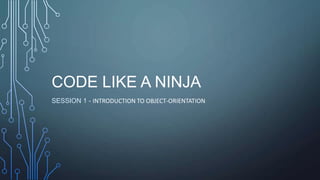Code like a ninja session 1 object-oriented principles
- 1. CODE LIKE A NINJA SESSION 1 - INTRODUCTION TO OBJECT-ORIENTATION
- 2. SESSION RESOURCES • Presentation session notes including link to this session, will be available on http://learningaboutfudge.blogspot.com • All the source for this session is publically available at: https://github.com/SheepWorx/Training • Source was compiled using Visual Studio 2012
- 3. WHY DO WE NEED TO KNOW THIS? • Dependency Management is an issue that most of us have faced. • Poor dependency management leads to code that is hard to change, fragile, and non-reusable. • When dependencies are well managed, the code remains flexible, robust, and reusable. - Robert C Martin (father of OOD)
- 4. WHAT WE WISH TO ACHIEVE The aim to write code that is • Testable • Reusable • Extensible • Maintainable • Less buggy
- 5. PRIMARY PRINCIPLES • Encapsulation • Abstraction • Inheritance • Polymorphism • Decoupling
- 6. ENCAPSULATION Definition: the hiding of non-essential features Laymen’s terms: making something Public, Protected, Internal, Protected Internal or Private [Code: OOPrinciplesEncapsulation]
- 7. ENCAPSULATION (CONT) • Public : Access is not restricted. • Protected : Access is limited to the containing class or types derived from the containing class. • Internal: Access is limited to the current assembly. • Protected Internal: Access is limited to the current assembly or types derived from the containing class. • Private : Access is limited to the containing type.
- 8. ABSTRACTION Definition: To only represent essential features of an object. Definition 2: To reduce and factor out details so that once can focus on a few concepts at a time Laymen’s terms: Reduce code redundancy and enable code reuse. [Code: OOPrinciplesAbstraction]
- 9. INHERITANCE Definition: a Mechanism to enable code reuse by abstracting code to subclasses or defining standard signatures using interfaces Laymen’s terms: Creating child-parent relationship between classes using normal classes, abstract classes or interfaces
- 11. POLYMORPHISM Definition: the provision of a single interface to entities of different types Laymen’s terms: Abstracting common functionality to a parent class and then creating child classes by inheriting the parent class, inheriting any accessible methods and properties along with it
- 13. DECOUPLING Definition: disconnecting an abstraction from its implementation so that the two can vary independently Laymen’s terms: Introducing a potato-class. If class1 and class2 are tightly-coupled by the one instantiating the other, to split off the dependency by introducing a 3rd class, usually in the form of an interface.
- 16. WHAT’S NEXT Topic: S.O.L.ID – The Single Responsibility Principle Where: 14:00-15:00 @ W4
Editor's Notes
- #2: Quick questionA popular question: What is Object-Orientation?Can anyone answer?
- #7: With encapsulation, you want to restrict access to various values or state.For ex, the most basic example is changing a property from public to private.Why do we want to do this? By limiting outside access to local variables of a class, for ex, you can exert more control over the applications behaviour, which should result in fewer bugs or at least, localized bugs.Demo Example
- #9: Abstraction and encapsulation go hand in hand and I see them both as one. In most cases where you’re encapsulating something, you’re also abstracting it.
- #11: This is also a form of polymorphism, which we will discuss in the next slide
- #15: Here we see that both Airtime and AccountPayment classes are tightly coupled to both basket and product controllerThis is a bad idea because, if we want to introduce a new class, for ex, Traffic fines, we’ll need to update both basket and Product controller as wellAlso, there is the possibility that a change in signature in either airtime or accountpayment, may have an affect on Productcontroller and basket.Lets assume that we want to test Basket in isolation, how will we go about decoupling it from the product controller?
- #16: Now we can test both productcontroller or basket in isolation.






![ENCAPSULATION
Definition: the hiding of non-essential features
Laymen’s terms: making something Public, Protected, Internal,
Protected Internal or Private
[Code: OOPrinciplesEncapsulation]](https://image.slidesharecdn.com/codelikeaninjasession1-object-orientedprinciples-140401151121-phpapp02/85/Code-like-a-ninja-session-1-object-oriented-principles-6-320.jpg)

![ABSTRACTION
Definition: To only represent essential features of an object.
Definition 2: To reduce and factor out details so that once can focus on
a few concepts at a time
Laymen’s terms: Reduce code redundancy and enable code reuse.
[Code: OOPrinciplesAbstraction]](https://image.slidesharecdn.com/codelikeaninjasession1-object-orientedprinciples-140401151121-phpapp02/85/Code-like-a-ninja-session-1-object-oriented-principles-8-320.jpg)

![INHERITANCE (CONT)
[Code: OOPrinciplesInheritance]
Before After](https://image.slidesharecdn.com/codelikeaninjasession1-object-orientedprinciples-140401151121-phpapp02/85/Code-like-a-ninja-session-1-object-oriented-principles-10-320.jpg)

![POLYMORPHISM (CONT)
[Code: OOPrinciplesPolymorphism]](https://image.slidesharecdn.com/codelikeaninjasession1-object-orientedprinciples-140401151121-phpapp02/85/Code-like-a-ninja-session-1-object-oriented-principles-12-320.jpg)



